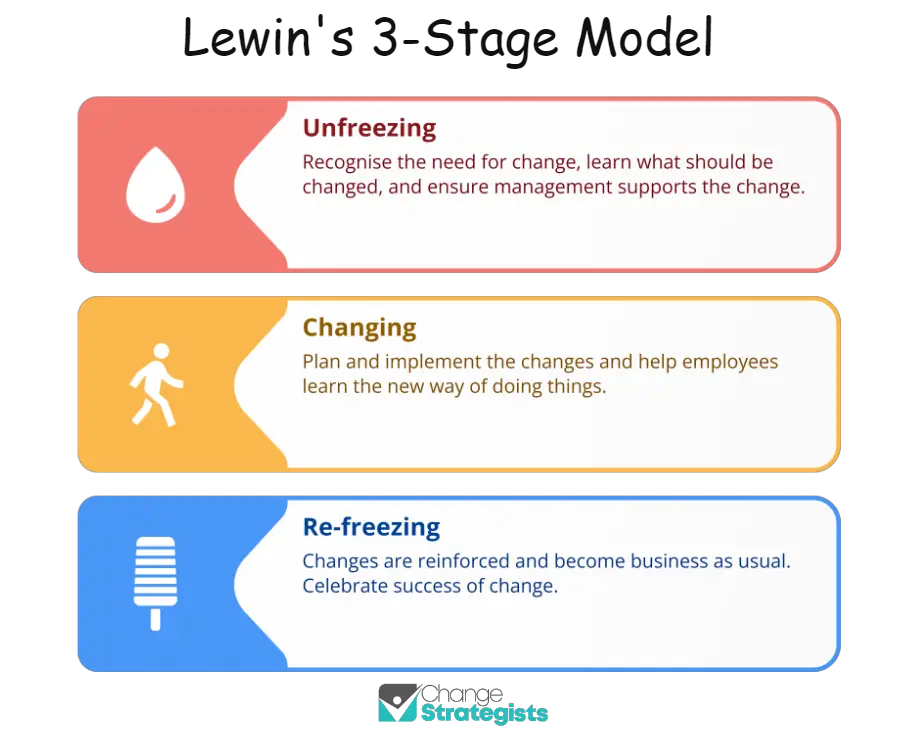Change is a constant in today’s business world. Companies are under pressure to keep up with the latest technology, trends, and customer demands. In order to stay competitive and maintain a successful business, Change Management has become vital for organisations. But what is change management?
Change management is the process of managing change in any organization. The main purpose of this process is to ensure that the changes being implemented by the company are beneficial to the employees, customers, shareholders, and other stakeholders.
It helps companies plan for, implement, and monitor changes within the organisation (such as new processes or technologies). This ensures that changes are made efficiently and effectively while minimising disruptions to the company’s operations.
This includes everything from training employees to making sure the new processes are documented properly. Change management is one component of a broader umbrella term called strategic planning.
Strategic Planning refers to how you think about where you want to go as a company and what it takes to get there.
There are three main stages of change management:
- Preparation: This stage includes activities such as developing a business case for change and creating a communication plan.
- Implementation: This stage includes activities such as training employees on new processes and procedures.
- Evaluation: This stage includes activities such as assessing whether the change was successful and making adjustments if necessary.
Why Is Change Management Important?
Changes can disrupt an organization if they are not planned and executed properly, which can lead to lost productivity, increased costs, and even employee morale problems.
Change management is an essential part of any project, regardless of size or complexity. This includes both internal changes within a company, such as adding a new feature, and external ones, like launching a new product.
In either case, there are many people involved, each with their own goals and objectives. If you don’t manage the process correctly, things can go wrong very quickly.
A well-planned change management strategy will help avoid confusion and miscommunication during the transition.
It will also make sure that everyone understands the reasons behind the change and how it affects them.
Without it, projects could fail because of lack of communication between stakeholders, leading to missed deadlines and unhappy customers.

What are the reasons for change?
The reasons for change can be categorized into three main groups:
- External factors such as the economy, public opinion or regulatory changes that demand a company to modernize quickly;
- Internal factors such as the need to reinvent the company and its products or to introduce new personnel; and
- Management factors such as improving organizational performance or increasing shareholder value.
What are the benefits of change management?
Change management is one of those terms that people use without really understanding what it actually means. In fact, many organizations don’t even know how to do it properly. But there’s no doubt that change management is essential to successful projects. And it’s something you’ll want to learn how to do well.
Change management is an essential part of any organization. It helps organizations adapt to changes in the environment, such as technological advancements, economic trends, and customer demands.
It is also critical to managing organizational growth and development.
Improve Organizational Performance
Organizations that implement effective change management practices tend to perform better than those that don’t.
For example, one study found that companies that had implemented successful change management programs were more productive and had higher revenues than those that hadn’t.
Increase Employee Engagement
According to one survey, employees who are disengaged costs U.S. businesses $500 billion annually.
By implementing effective change management practices, employers can engage the workforce in the process, reduce employee turnover rates and save money.
Increase Productivity
Effective change management practices improve productivity. This is especially true for small and medium-sized enterprises.
Smaller firms often lack resources to manage change effectively. As a result, these firms struggle to maintain a competitive edge against larger rivals.
However, when smaller firms adopt effective change management practices, they are able to compete successfully against bigger competitors.
Enhance Customer Satisfaction
When customers feel valued, they are more willing to recommend products and services to others.
As a result, companies that implement effective change management techniques are more likely to retain existing customers and attract new ones.
Manage Organizational Growth
Companies that implement effective change management strategies are better equipped to grow and develop.
They are able to identify opportunities for growth and capitalize on them.
These companies are also better prepared to respond to changing conditions in the marketplace.
So, if you want to see your company thrive, then you should invest in effective change management practices.

What are the challenges of change management?
The most common challenges when dealing with change include:
Resistance to change
Resistance occurs when someone does not want to accept something new or different. People may resist change if they feel threatened by the change, or if they believe that the change will cause them harm. When dealing with change, managers need to identify whether the change is causing resistance among their staff members. If it is, then they have to find out why the staff member is resisting the change. Once the manager knows why the employee is resistant, he or she can work to resolve the issue.
Disruption during change
Disruption happens when things do not go according to plan. Sometimes disruption is caused by external factors, such as weather conditions; however, sometimes disruptions happen internally, due to human error. Managers must learn to deal with disruptions effectively. One way to handle a disruption is to take action immediately. Another method is to try to avoid the problem altogether. A third option is to make adjustments after the fact.
Communication of change
Communication is the exchange of information between two or more individuals. Good communication helps people understand each other and makes everyone involved in the conversation feel comfortable. Effective communication requires clear and concise messages.
Feedback about change
Feedback is any kind of information collected about performance. It can be positive or negative feedback, the important thing is that you collect feedback about the changes being made and act on it accordingly.
Resolution of Conflict due to change
Conflict resolution is the act of resolving conflict between two or more parties. Conflict can often arise during change where there is disagreement over how the change should be implemented. The best way to resolve this type of conflict is through open dialog.

What are the reasons for change failure?
There are many reasons why change initiatives can fail. Some of the most common reasons include:
- Bottom-up support for change is lacking.
- Change management support is weak.
- The initiative lacks inspiring leadership.
- Leadership ignores change resistance as a source of learning.
- Management pushes too hard and doesn’t recognize organizational exhaustion.
- The plan is rigid and doesn’t adjust to upcoming developments.
When leaders don’t fully commit to and champion the change, it can be difficult to get team members on board and ensure that all stakeholders are adequately informed and participate in the transformation process.
If team members don’t believe in the need for or benefits of the change, they may be less likely to invest in it or engage constructively in its implementation.
Some individuals or groups may be reluctant to take on new challenges or try new approaches because they’re afraid of potential risks involved. This can stall progress and result in failed changes insofar as they fail to meet desired objectives.
What are the principles of change management?
There are four principles of change management, which are:
- Identification and definition of the need for change
- Preparation and initiation of change
- Refreeze the change
- Monitoring and managing changes
The first principle is that change agents need to identify what precisely they want to change. This means identifying the problem or opportunity that needs to be addressed, as well as the desired outcome of the change.
The second principle is to change the system. This means implementing the changes necessary to address the problem or opportunity identified in the first principle.
The third principle is to refreeze, which means consolidating the changes made in order to ensure that they stick and become part of the new status quo.

The fourth and final principle is to evaluate and monitor progress, which means constantly assessing how well the changes are being implemented and whether they are having the desired effect.
What are the project phases of change management?
The project phases of change management are:
- Initiation
- Planning
- Executing
- Monitoring
- Closing.
In this structured approach, the execution phase is the most important because it’s when the actual changes are implemented. The change management team should be placed in a project team member or have a centralized role.
The team should be responsible for identifying who will be doing what during the execution phase of the project.
What are the project models of change management?
There are three project models of change management:
The emergency model. This type of change management is used when there is a problem that needs to be fixed quickly.
The corrective action model. This type of change management is used when there is a problem that needs to be fixed, but it does not need to be fixed immediately.
The transformative model. This type of change management is used when a company wants to make a significant change that will have a positive impact on the company.
What is the role of communication in change management?
Effective communication is crucial for successful change management. Communication plays a vital role in ensuring that all parties involved are aware of changes and can make decisions accordingly.
In order to successfully execute change management, it is important to have a strong understanding of communication channels and how they can be used to facilitate collaboration and achieve success.
Communication is also necessary for resolving any conflicts that may arise during the change process.
What is the role of leadership in change management?
Leaders play an important role in the implementation of change management. Leaders help to guide and support the change management strategy.
Leaders work with project teams and business partners who are eager for change. Leaders must be able to build cross-functional relationships, think critically, and take initiative to drive results.
Leaders must create a supportive environment in which team members feel comfortable experimenting and exploring new ideas, as well as promoting consensus building during challenges.
What is the role of team in change management?
Forming a team is essential in change management because it helps to manage emotions and preconceived notions and provides a forum for communication, input and support.
Additionally, team members can provide outside perspective on processes and challenges that may have arisen thus far.
An Organizational Change Management (OCM) management team is made up of several positions, often help in addition to the day to day job:
- OCM sponsor: a senior executive, often the CEO.
- OCM program manager: directs the day-to-day activities of the OCM team.
- OCM project manager works closely with the overall program manager responsible for implementing the change.
OCM staff, known as OCM Champions, are supporters of the change who “sell” the benefits to specific departments, business units, and individuals.
After implementation, Champions continue to make sure the change is supported and used by the individuals whose jobs have changed.
What are the tools of change management?
There are many tools of change management. Some common ones include:
- Flowcharts/process maps
- Culture mapping
- Gantt charts
- ADKAR analysis
- Force field analysis
- Kotter’s 8 step change model
- Lewin’s change model
Change management tools help organizations plan for and implement changes. P opular change management software platforms include the following:
- ChangeGear (Serviceaide)
- ChangeScout (Deloitte)
- eChangeManager (Giva)
- Freshservice (Freshworks)
- Remedy Change Management 9 (BMC Software).
What is the difference between change management and project management?
Change management is a broader term that covers a range of different disciplines, while project management is a narrower term that focuses on managing projects.
Change management includes a range of different models, while project management focuses on a specific model.
The most common change management model is Lewin’s three-stage model of change, which includes unfreezing, changing and refreezing. Other popular models include Kotter’s eight steps for leading change and Bridges’ transition model.
Change management is about preparing, equipping and supporting individuals as they go through changes, while project management is about managing projects and ensuring their success.
Change management helps individuals understand why the change is happening, what will happen during the change process and how they will be affected by the change.
Project management, on the other hand, focuses on planning, executing and monitoring the project to ensure it is completed on time and within budget.
Conclusion
In conclusion, change management involves the process of managing the organization’s transformation from its current state to a desired future state.
The success of any initiative requires careful planning that takes into account many factors such as organizational readiness, available resources, and stakeholders’ needs.
To learn more about change management check out the rest of our website. We have lots of free articles on topics like this!
Sources
https://www.hrcloud.com/blog/8-employee-engagement-statistics-you-need-to-know-in-2021
https://www.gallup.com/workplace/321965/employee-engagement-reverts-back-pre-covid-levels.aspx




